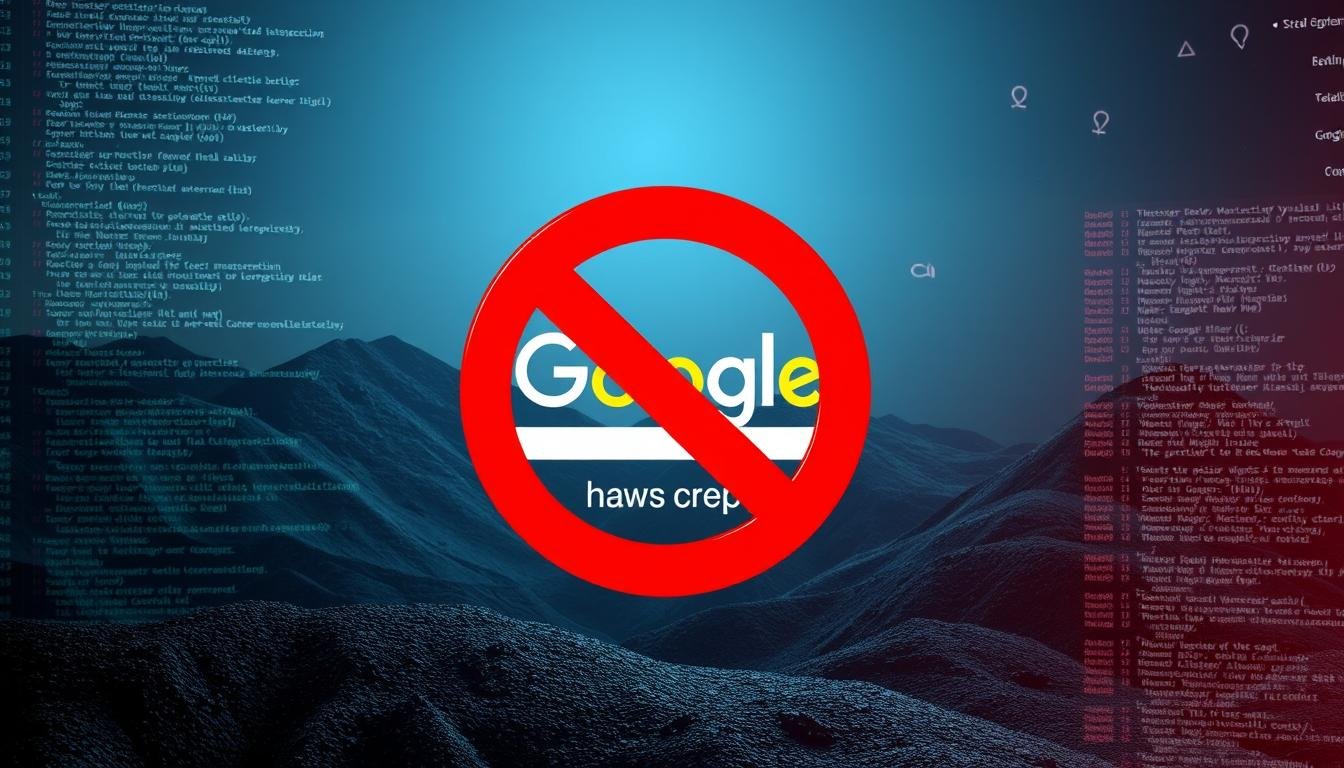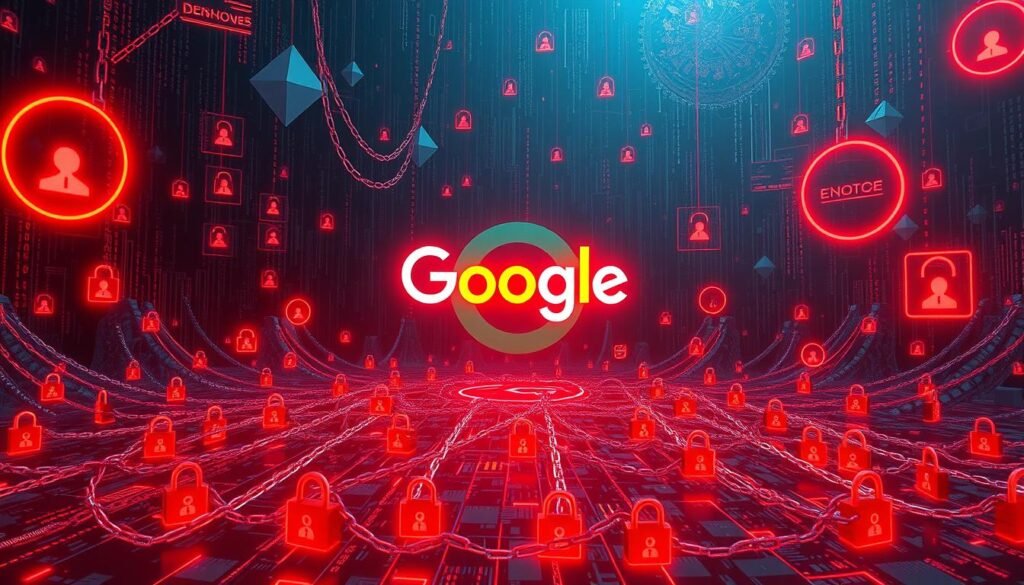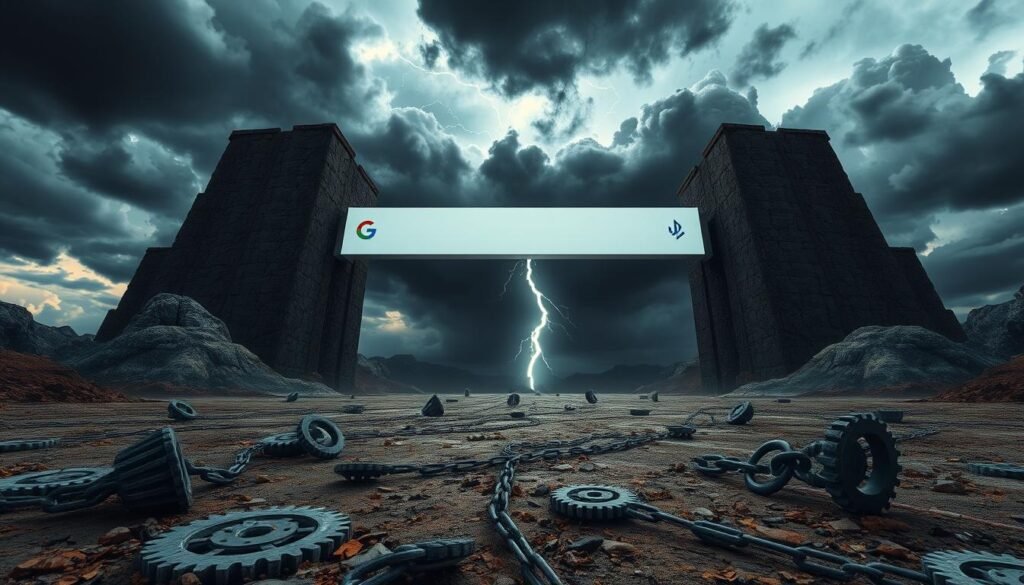
Imagine one morning, your website is gone from Google’s search results. About 8.5 billion searches happen on Google every day1. Missing from Google for even a day is like being lost in a huge ocean. Asking “Can you be banned from Google?” is a real worry. For any business, big or small, being seen on Google is crucial for success.
Think about JC Penney. They suffered a big drop in Google’s rankings in 2011. This happened because they broke rules related to links on their website2. This story shows how serious it is to follow Google’s guidelines. You can get banned for many reasons, like using too many keywords or too many ads12. Sometimes, Google might ban you for a short time or even forever, based on what you did wrong1.
Knowing about Google’s banning is important for your website’s traffic and presence. Let’s explore Google’s ban rules. We’ll learn how to keep your site safe, seen, and successful.
Understanding Google’s Ban Mechanics
Exploring Google means knowing how their rules affect your website. Following Google’s guidelines is essential to keep your site visible. It helps users easily find and access it.
How Google's Terms and Policy Influence Your Website
Google has strict rules to make search safe and dependable. Breaking these rules might get your website banned without warning. Offenses like hosting malware, copying content, or tricking users can cause big penalties. Google wants users to find safe, relevant, and quality content.
For digital marketers, organic search is key for getting customers, with 70% naming it their top method. This shows how important it is to follow SEO best practices from Google3.
Website Suspensions and Terminations Mechanism
Knowing how Google bans websites can prevent your site from getting blocked. Google uses manual and automatic methods to enforce rules. It has stopped over 3 billion bad ads and many phishing sites3. Google combines technology and human review to keep search results clean.
About 70% of search ranking drops are due to algorithm penalties, hitting sites that depend on organic traffic hard3. Staying in line with Google’s guidelines is critical.

As Google updates its policies, keeping up is crucial. Knowing why Google might ban or penalize your site is important. This is the best way to make sure your site stays visible and usable online.
Can You Be Banned From Google?
Ever wondered if your online actions could get you banned by Google? There are many reasons Google might ban someone. These can range from small mistakes to big wrongdoings. It’s essential for us to understand these risks. After all, Google is a big part of our digital lives.
Being cut off from Google services like Gmail and Google Drive changes how we use the internet. It makes it hard to do everyday things online. Imagine not being able to get to your important personal data4. It’s not just a minor issue; it can mess things up big time.
Google search penalties can affect many parts of a website’s functioning. About 5% of websites get hit by a Google penalty. This can change due to many things like updates in Google’s rules6.
Avoiding a ban is easier than fixing one. By knowing why Google bans and the results of breaking their rules, you can protect your online life. This way, you can keep using Google’s services without any problems.

Identifying Different Types of Google Bans
Understanding the difference between temporary Google bans and permanent Google bans is crucial. These can deeply affect your online presence. This guide uses real examples to explain how easy it is to fall from Google’s good graces.
The Impact of Temporary Bans on Your Online Presence
Temporary bans usually happen for small mistakes or being a first-time offender. For instance, if you post duplicate content by accident, Google might temporarily lower your site’s ranking. This leads to less visibility and fewer visitors7.
While under a temporary ban, your website may vanish from search results. It’ll return once you fix the issue and talk to Google. This can confuse regular visitors and hinder new user gains7.
Permanence of Bans: What It Means to Lose Google Services Forever
Being permanently banned from Google is severe. It means you broke the rules in a big way. Using forbidden SEO tactics, like hiding keywords or misleading links, can cause this grave scenario7.
Recovering from a permanent ban isn’t easy. It usually requires changing a lot of what you do. Even then, getting back into Google’s good books might not happen7.
Knowing these risks shows the value of following Google’s rules. Stick closely to Google’s guidelines to keep your website safe. Always be ready for new updates from Google to avoid getting banned8.
As you move forward with your website, balance the pros and cons of your strategies. Keep an eye on Google’s policy changes. Navigating Google’s rules is tricky, but staying informed can prevent a ban.
Analyzing Common Reasons for Google Banning Websites
Ever wonder why a site gets banned by Google? The main reasons include broken rules and using forbidden SEO tricks. Content that doesn’t follow rules and using sly SEO tactics often lead to bans or penalties9.
| SEO Violation | Frequency | Impact on Visibility |
|---|---|---|
| Keyword Stuffing | High | Severe Reduction |
| Cloaking | Moderate | Temporary to Permanent Ban |
| Unnatural Links | Common | Severe Reduction or Ban |
| Thin Content | Very Frequent | Significant Drop in Rank |
Other reasons for penalties include harmful content, hate speech, and scams. These breach Google’s rules and can make the internet less safe9.
- Following Google’s rules and policies can prevent the vast majority of bans.
- Regularly checking Google Search Console helps detect and resolve issues before they escalate into penalties.
If you’re dealing with a Google penalty, acting fast is crucial. Appeal the penalty or fix the issues to get back on track. Keep your SEO honest and your account secure to avoid these problems9.
Being aware and compliant is key to avoiding Google penalties. Stay vigilant and follow Google’s guidelines to keep your site visible and growing.
Detecting a Google Ban: Signs and Symptoms
If you notice a sudden drop in your site’s traffic, it could mean a Google penalty. Don’t panic. Knowing the right steps can help you find and fix the problem.
What to Do When You Suspect a Ban
The first step is to check your Google Search Console if you think your site has been banned. Look for any alerts or messages from Google. These can tell you a lot. For example, a notification about a manual action means a reviewer has found issues with your site not following Google’s guidelines11.
Another key step is to do a simple Google search for “site:yourwebsite.com” to see if your site is indexed. If there are no pages found, it likely means your site was removed from Google’s index. This could be for severe reasons, like using misleading practices, as happened with a well-known carmaker in 200612.
Using Google Webmaster Tools to Confirm a Penalty
Google Webmaster Tools, or Google Search Console, helps you identify any penalties on your website. Check the ‘Manual Actions’ section for detailed reports on the problem and how to fix it11.
You might also see an automatic penalty, such as a PageRank penalty or a sudden rank drop. These can come from issues like poor content or low-quality links12. These penalties can greatly lower your site’s visibility and traffic.
Understanding these signs and using Google Webmaster Tools can help you start fixing the problem. Making sure your site follows Google’s rules and keeping an eye on its status can help avoid future issues11.
Proactive Measures
To keep your online presence strong and free from penalties, it’s important to take action early. Follow ethical SEO practices and build links wisely. These steps will help you avoid the stress of Google penalties.
Best Practices for White-Hat SEO and Link Building
Industries like garage door repair, plumbing, and real estate face more scrutiny. They need to strictly follow white-hat SEO. These areas are watched closely by Google for any sketchy activity13. To avoid penalties, don’t stuff your content with too many keywords, post inappropriate content, or misrepresent your business13.
| SEO Practice | Benefits | Common Pitfalls to Avoid |
|---|---|---|
| Link-Building Strategies | Improves site authority and ranking | Spammy links, purchasing links |
| Ethical Content Creation | Engages users, fosters trust and credibility | Plagiarism, keyword stuffing |
| Data Security Compliance | Protects user data, builds trust | Lax security measures, non-compliance to standards like GDPR |
Using white-hat strategies in your SEO work helps avoid Google penalties. It also makes your website more trustworthy and authoritative.
The Consequences of Violating Google Guidelines
A google penalty can be quite severe. For major violations, your account could be suspended immediately. This is to stop illegal acts or serious harm to users1617. Google wants to keep the internet safe for everyone. But if your mistake isn’t too bad, you’ll get a warning first. With each mistake, penalties get worse, leading to suspension after three strikes1617.
- Immediate suspension for severe policy breaches ensures quick action against potential threats17.
- Systematic strikes for repeated violations underline the escalating nature of google penalty consequences17.
- Ad disapprovals and the disabling of remarketing lists that don’t comply with policies like the Personalized advertising policy could halt major aspects of your digital marketing efforts1617.
The effects go beyond warnings, though. Violations could mean less website traffic, lower visibility, and even a damaged reputation. These outcomes highlight the risks of not following Google’s rules.
| Penalty Type | Immediate Consequences | Long-term Impact |
|---|---|---|
| Ad Disapproval | Stops ad from running | Loss of immediate ad revenue |
| Account Warning | Notification of potential suspension | Chance to rectify issues before escalation |
| Account Suspension | Ceases all ads; suspends account activities | Long-term or permanent loss of account privileges |
| Remarketing List Disabled | Halted use in campaigns | Impact on targeted marketing efforts |
| Compliance Review Required | Must respond to and correct issues promptly | Improved adherence to policies, or risk further actions |
But remember, following Google’s guidelines matters a lot. It’s not just about avoiding trouble. It shows you’re trustworthy online. Keeping to the rules improves your reliability and boosts your reputation.
The Recovery Process After a Google Penalty
If you’ve been hit with a Google penalty, getting to work on recovery is essential. First, figure out if the penalty is manual or algorithmic. This will tell you how to start fixing your site to improve its rank in search results.
Steps to Regain Lost Search Engine Ranking
Begin with a deep audit to find what caused the penalty. If it’s a manual penalty, Google’s Webmaster Tools will detail the issues, like bad links or too many keywords. You’ll need to fix these problems directly. For algorithmic penalties from updates like Penguin or Panda, it’s all about boosting your content quality and following Google’s guidelines1819. To lift a Google penalty, start by fixing or removing harmful content or links. Then, ask Google to reconsider your site18.
Google Webmaster Tools for Recovery
Use Google Webmaster Tools to get your ranking back. This platform helps you file for reconsideration after making fixes, and keep an eye on penalties. It helps you adjust your site to fit the latest Google ranking factors19. It’s also great for talking directly with Google, so you understand exactly what went wrong and how to fix it20.
During recovery, focus on fixing issues and also on making your site better overall. Align your site with Google’s latest updates and guidelines to avoid future penalties.
Recovery from a Google penalty takes time and effort. By sticking to Google’s rules, you can get back your rankings and build a stronger web presence. Don’t give up—evaluate and improve continuously. Often, success is just a few smart moves away.
Avoiding Black Hat SEO Techniques
Hey there, in the busy online world, taking shortcuts to increase your site’s visibility might seem tempting. But beware! Using black hat SEO tactics can do more damage than good. It looks like an easy win but it’s a dangerous path. Google keeps an eye out for tricks that break its rules21. If you get caught, you could face penalties, drop in rankings, or get removed from Google’s index entirely22.
Think of your website as a work of art. Using questionable methods like cloaking or participating in link schemes ruins it22. Also, stuffing your content with too many keywords or buying links is pointless and messy23. Instead, white-hat link building can make search engines trust your site. That’s way better for you in the end21.
To avoid trouble with Google, stay true and genuine. Work on making your content excellent for users. This lets the natural SEO process work in your favor. Going slow and steady is the best approach. Stay away from those black hat tactics. Your future self will be grateful for using honest methods. This keeps your site safe from penalties21. So, let’s choose to be the good folks in the digital space. Staying on the right side of search engine rules is the best strategy for success.
FAQ
Can You Be Banned From Google?
Yes, you can. If you break Google’s rules or do things like spamming, you can get suspended or even banned. This means your site won’t show up in search results anymore.
How Do Google’s Terms and Policy Influence Your Website?
Google’s rules set what’s okay and what’s not for websites. Following these rules keeps your site safe with Google. But breaking them can lead to penalties.
What is the Mechanism Behind Website Suspensions and Terminations?
Google checks websites with both automatic tools and people. If they find problems, they might suspend or end your website’s presence in search results.
What Are the Common Reasons for Google Banning Websites?
Websites get banned for using bad SEO tricks, stealing content, and spreading harmful software.
How Can a Temporary Ban Affect Your Online Presence?
A temporary ban can drop your site’s ranking or remove it from search results. This means less people can find your site until Google removes the ban.
What Does It Mean to Lose Google Services Forever?
Being banned forever means a big problem was found. Your site will be gone from Google searches for good. This can really hurt your online business or reputation.
How Do You Detect a Google Ban?
If your traffic suddenly drops or your site disappears from search results, you might be banned. Google Webmaster Tools will tell you if there’s a manual action on your site.
What Should You Do If You Suspect a Ban?
Check Google Webmaster Tools for alerts. Review your site against Google’s rules and fix any problems.
What Are the Best Practices for White-Hat SEO and Link Building?
Create helpful content and use keywords right. Get links from good websites and make your site user-friendly.
What Are the Consequences of Violating Google Guidelines?
Breaking Google’s rules can make your site rank lower, lose traffic, and hurt your reputation. Fixing this can be hard.
What Steps Should Be Taken to Regain Lost Search Engine Ranking After a Penalty?
Find the penalty’s cause with Google Webmaster Tools. Fix your site, ask Google to recheck, and wait for their okay.
How Can Google Webmaster Tools Aid in the Recovery Process?
Google Webmaster Tools shows how your site’s doing and points out problems. It helps you ask Google to reconsider after fixes.
How Can You Avoid Black Hat SEO Techniques?
Learn SEO best practices and follow Google’s guidelines. Use honest SEO, keep your content original, and always think of the user first.
Source Links
- https://www.bkacontent.com/can-you-get-banned-from-google/
- https://www.cyberoptik.net/blog/6-sure-fire-ways-to-get-banned-from-google/
- https://www.ablison.com/can-you-be-banned-from-google/
- https://www.androidauthority.com/google-account-banned-1054640/
- https://speedybrand.io/blogs/can-you-get-banned-from-google
- https://www.hireawriter.us/seo/can-you-be-banned-on-google
- https://purebredmarketing.com/blog/is-it-possible-to-get-banned-from-google/
- https://www.seo.com/blog/how-to-remove-a-google-ban/
- https://www.stanventures.com/news/can-you-be-banned-from-google-1221/
- https://medium.com/hireawriter/can-you-be-banned-on-google-173dadda5a6b
- https://www.netzole.com/how-to-check-if-your-site-is-banned-in-google-and-fix-it/
- https://tastyplacement.com/how-to-diagnose-a-google-penalty
- https://www.demandhub.co/articles/google-business-profile-suspended/
- https://www.jotform.com/google-forms/are-google-forms-secure/
- https://promevo.com/blog/google-workspace-violations-policy
- https://support.google.com/adspolicy/answer/7187501?hl=en
- https://support.google.com/adspolicy/answer/7187501?hl=en-GB
- https://seomatic.ai/blog/google-penalty-recovery-process-programmatic-seo-sites
- https://www.link-assistant.com/news/google-penalties-guide.html
- https://www.stanventures.com/blog/google-penalties/
- https://www.shopify.com/au/blog/black-hat-seo
- https://www.seozoom.com/black-hat-seo-beware-of-forbidden-techniques-on-google/
- https://www.elegantthemes.com/blog/wordpress/black-hat-seo-techniques-tactics
